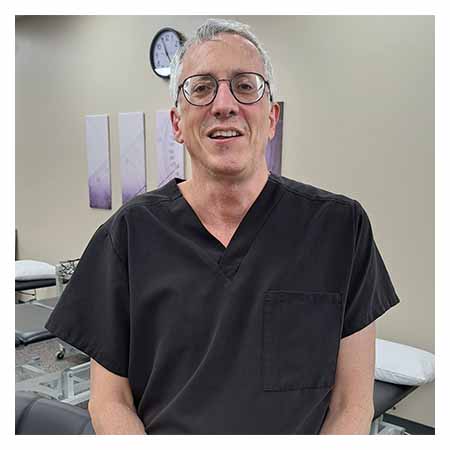Diagnosis and Repair of Empty Nose Syndrome in a Physician
 Steven Sapsowitz, MD, a family physician practicing in The Woodlands, Texas, was hit with the end of a hockey stick at the age of 7 while living in New York City. The injury caused a severe deviated septum, with a nasal valve collapse on the left. As he grew, the valve collapsed further. In addition, he suffered severe allergies that enlarged the turbinates inside his nose, and the combination of the collapsed nasal valve, allergies, and turbinate hypertrophy blocked his ability to breathe.
Steven Sapsowitz, MD, a family physician practicing in The Woodlands, Texas, was hit with the end of a hockey stick at the age of 7 while living in New York City. The injury caused a severe deviated septum, with a nasal valve collapse on the left. As he grew, the valve collapsed further. In addition, he suffered severe allergies that enlarged the turbinates inside his nose, and the combination of the collapsed nasal valve, allergies, and turbinate hypertrophy blocked his ability to breathe.
“That was the beginning,” Dr. Sapsowitz says. “Every now and then, starting in medical school, I had to take antibiotics for chronic rhinosinusitis. In 1990, an ENT doctor in Houston corrected the deviated septum and also trimmed my turbinates.”
Then 20 years later, he saw an otolaryngologist who diagnosed the same nasal valve collapse – the earlier surgery had failed to relieve his symptoms – as well as turbinate hypertrophy. Another surgeon in the same practice repaired the nasal valve and trimmed most of Dr. Sapsowitz’s inferior turbinate on the right side. “He straightened the septum a little more, and I felt better,” he says.
Although he still had the same severe allergies he suffered as a child, things went well until May 2021, when he again developed a sinus infection. Antibiotics improved his condition, but a few weeks later he developed a more severe infection. An otolaryngologist cultured the discharge, which pathology identified as methicillin-resistant Staphylococcus aureus (MRSA), and his physician prescribed levofloxacin. He recommended an in-office ethmoidectomy and balloon sinuplasty, but Dr. Sapsowitz felt uncomfortable undergoing the procedure in his office.
“By then, I was really getting depressed,” he says. “I had recurrent allergies and pus coming from my sinuses. Meanwhile, I saw a nearby ENT in The Woodlands. After a CT scan, he recommended the same procedures as the previous physician, but instead of doing a complete ethmoidectomy, he only did a partial on the left. No problem, but he also trimmed all my remaining turbinates except the middle turbinate on the right.”
After the surgery, Dr. Sapsowitz experienced continued burning sensations and pain. “It felt like I was breathing through a wind tunnel. My nasal passages felt hollow, and the air was just gushing in and out,” he says. “Paradoxically, I could not feel myself breathing through my nose at all. I also had a horrible emptiness in the left side of my nose that made me feel like I wanted to die. I started having problems concentrating and sleeping, and felt extremely distressed. I paced the hallway in my house and looked at myself in the mirror thinking about how I might end my life. I don’t know how I managed to work through this time without taking a leave of absence.”
In January 2022, he was on the phone with his first cousin while she was picking up a friend from Houston. The friend overheard the conversation and suggested he see Russell Kridel, MD, an otorhinolaryngologist and facial plastic surgeon. Dr. Kridel referred him to Martin Citardi, MD, professor, chair, and Memorial Hermann Chair in the Department of Otorhinolaryngology at the medical school.
“I was sitting in Dr. Citardi’s office thinking why am I here?” Dr. Sapsowitz says. “There’s nothing more this man can do for me. But as soon as he walked in, it was night and day from my past experiences. He knew exactly what was wrong with me, how much I was suffering, and what to do about it.”
Dr. Sapsowitz had empty nose syndrome (ENS), which occurs when physicians remove too much nasal tissue during surgery, causing nasal airflow disruption. To identify candidates for surgery, Dr. Citardi uses a validated patient questionnaire and an in-office cotton test. “We place a small piece of cotton in the area of the missing tissue and ask patients if they perceive a difference,” he says. “If they do, we know they are candidates for turbinoplasty. The cotton test tells us where to repair the turbinates.”
Dr. Citardi says it’s not uncommon for patients with empty nose syndrome to become fixated to the point that they are unable to function in daily life. “They also report high levels of anxiety and depression, as Dr. Sapsowitz did,” he says.
He is among a handful of rhinologists who treat ENS patients. “Data measuring the prevalence of empty nose syndrome after turbinate surgery are limited, which may reflect a low incidence, or the fact that many cases are unrecognized and unreported,” he says. “Another factor that complicates diagnosis is the delay in some patients in the development of symptoms, which can range from months to years. Removing too much tissue is not as common as it was in the past, but some surgeons continue to practice complete or near-complete turbinate resection for maximal opening of the nasal airway. Fortunately, this is a rare condition, and we have a reliable way to diagnose and treat it.”
Dr. Citardi implanted a collagen matrix to replace the missing tissue in the left nasal cavity in March 2022. “I felt immediately better,” Dr. Sapsowitz says. “The nasal mucosa will grow into and around the graft, and it will last a lifetime. After all I had been through, the relief I felt was unbelievable. I told him he saved my life. He did the second surgery on the right side in July. To even have contemplated suicide is incomprehensible to me now.”